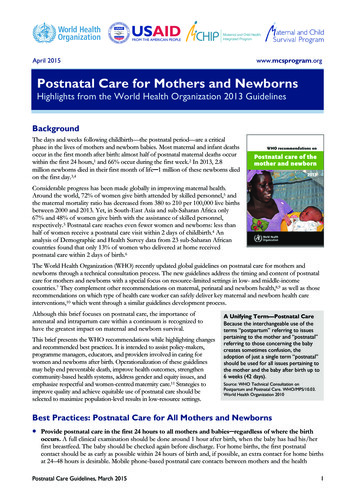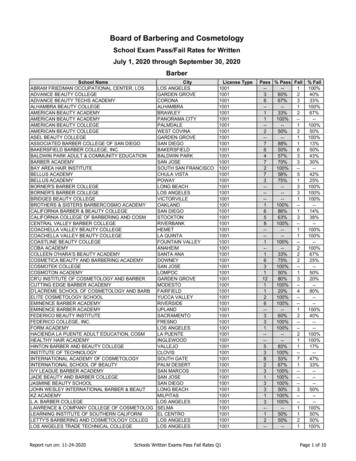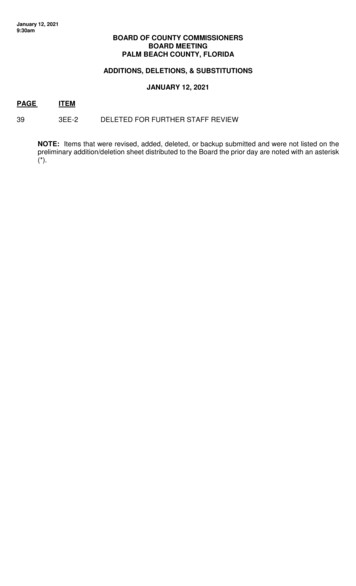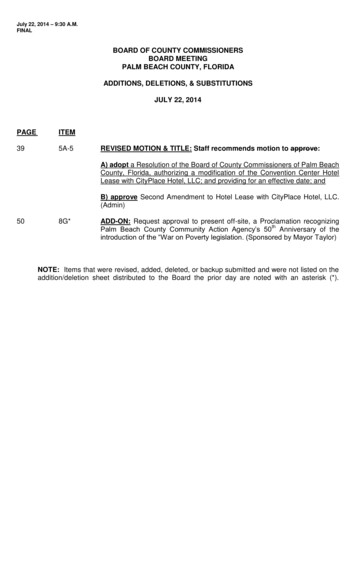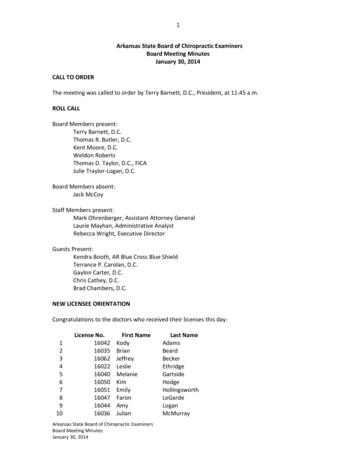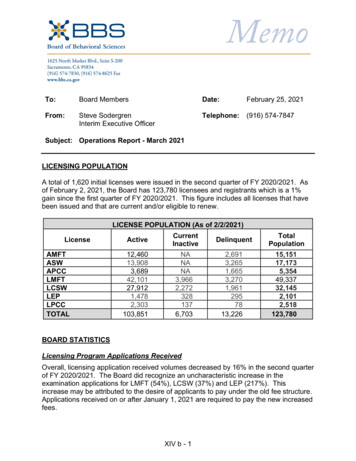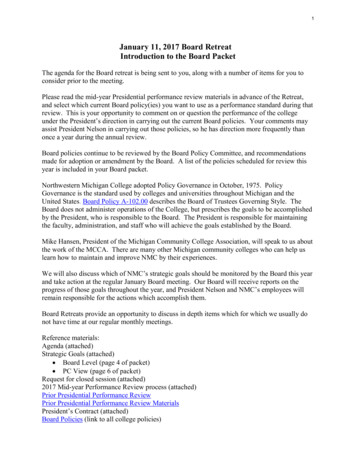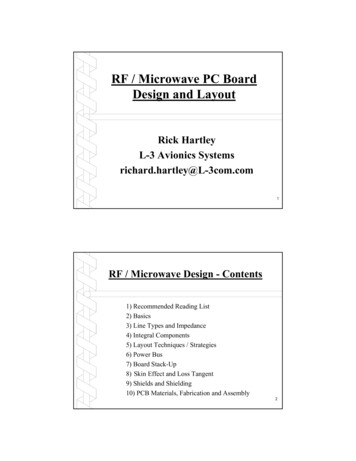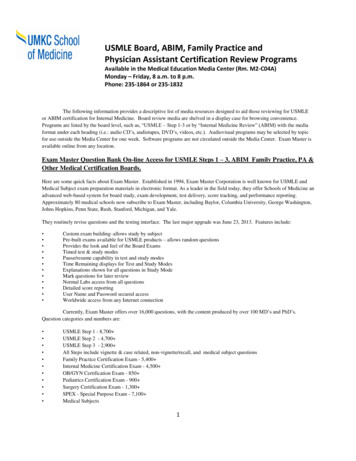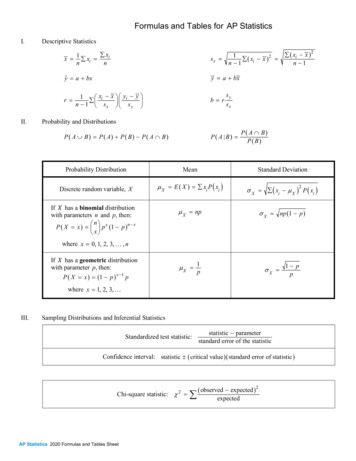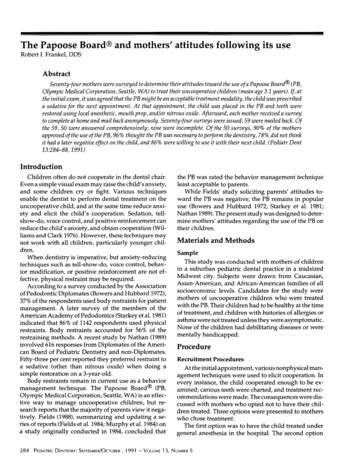
Transcription
The Papoose Board and mothers’ attitudesfollowingitsuseRobert I. Frankel, DDSAbstractSeventy-four motherswere surveyed to determinetheir attitudes towardthe use of a , WA)to treat their uncooperativechildren (meanage 3.1 years). If,the initial exam,it was agreedthat the PBmightbe an acceptabletreatmentmodality, the child wasprescribeda sedative for the next appointment. At that appointment, the child was placed in the PB and teeth wererestored using local anesthetic, mouthprop, and ornitrous oxide. Afterward, each motherreceived a surveyto complete at homeand mail back anonymously.Seventy-four surveys were issued; 59 were mailed back. Ofthe 59, 50 were answeredcomprehensively; nine were incomplete. Of the 50 surveys, 90%of the mothersapprovedof the use of the PB, 96%thought the PBwas necessary to performthe dentistry, 78%did not thinkit hada later negative effect on the child, and86%werewilling to use it with their next child. (Pediatr Dent13:284-88, 1991)IntroductionChildren often do not cooperate in the dental chair.Even a simple visual exammay raise the child’s anxiety,and some children cry or fight. Various techniquesenable the dentist to perform dental treatment on theuncooperative child, and at the same time reduce anxiety and elicit the child’s cooperation. Sedation, tellshow-do, voice control, and positive reinforcement canreduce the child’s anxiety, and obtain cooperation (Williams and Clark 1976). However, these techniques maynot work with all children, particularly younger children.Whendentistry is imperative, but anxiety-reducingtechniques such as tell-show-do, voice control, behavior modification, or positive reinforcement are not effective, physical restraint maybe required.According to a survey conducted by the Associationof Pedodontic Diplomates (Bowers and Hubbard 1972),37%of the respondents used body restraints for patientmanagement. A later survey of the members of theAmerican Academyof Pedodontics (Starkey et al. 1981)indicated that 86%of 1142 respondents used physicalrestraints.Body restraints accounted for 56%of therestraining methods. A recent study by Nathan (1989)involved 616 responses from Diplomates of the American Board of Pediatric Dentistry and non-Diplomates.Fifty-three per cent reported they preferred restraint toa sedative (other than nitrous oxide) when doingsimple restoration on a 3-year-old.Body restraints remain in current use as a behaviormanagement technique.The Papoose Board @ (PB,Olympic Medical Corporation, Seattle, WA)is an effective way to manage uncooperative children, but research reports that the majority of parents view it negatively. Fields (1988), summarizing and updating a series of reports (Fields et al. 1984; Murphyet al. 1984)a study originally conducted in 1984, concluded that284the PB was rated the behavior management techniqueleast acceptable to parents.While Fields’ study soliciting parents’ attitudes toward the PB was negative, the PB remains in popularuse (Bowers and Hubbard 1972; Starkey et al. 1981;Nathan 1989). The present study was designed to determine mothers’ attitudes regarding the use of the PB ontheir children.Materials and MethodsSampleThis study was conducted with mothers of childrenin a suburban pediatric dental practice in a midsizedMidwest city. Subjects were drawn from Caucasian,Asian-American, and African-American families of allsocioeconomic levels. Candidates for the study weremothers of uncooperative children who were treatedwith the PB. Their children had to be healthy at the timeof treatment, and children with histories of allergies orasthma were not treated unless they were asymptomatic.None of the children had debilitating diseases or werementally handicapped.ProcedureRecruitment ProceduresAt the initial appointment, various nonphysical management techniques were used to elicit cooperation. Inevery instance, the child cooperated enough to be examined; carious teeth were charted, and treatment recommendations were made. The consequences were discussed with mothers who opted not to have their children treated. Three options were presented to motherswho chose treatment.The first option was to have the child treated undergeneral anesthesia in the hospital. The second optionPEDIATRIC DENTISTRY: SEPTEMBER/OCTOBER, 1991 VOLUME13, NUMBER5
was treatment in the dental office. The child would besedatedwith chloralhydrate(25 mg/kg) andpromethazine, which might be supplemented with nitrous oxide. If the child cooperated at that time, then alocal anesthetic and mouth prop might be used, and nofurther behavior managementwould be needed. If thisdid not produce a cooperative child, a third option wasto wrap the child in the PB while the dental procedureswere being performed. A local anesthetic would beinjected and a mouth prop and/or nitrous oxide mightbe used.If the mother accepted either of the last two options,she gave consent. The mothers sampled were parents ofchildren who required management with option 3.Operative ProceduresAt the second appointment, the sedated but uncooperative child was shown the PB and an Indian game wasplayed as the child was being wrapped. Later, if nitrousoxide was needed, an astronaut game was devised. Themother and the assistant placed the child on the PB,verbally supporting the child. The child was allowed tocry without dental staff or parent displaying anger. Thechild was wrapped comfortably, with one hand free tohold the mother’s hand. The mother was required to bepresent during the visit to comfort and support thechild, and aid in decision makingfor the child’s wellbeing. A mouth prop was used on children who did notkeep their mouths open. A topical anesthetic was applied and a local anesthetic was administered. Whilethe anesthesia, and sometimes nitrous oxide, was taking effect, the mother was assured that much of thecrying was out of fear. Tell-show-do was used to helpallay fear.When the planned treatment was completed, thechild was released and given appropriate rewards. Themother was given postoperative instructions, and alsowas issued the survey to take home and mail backanonymously.Survey InstrumentThe survey consisted of two sections. The first section requested demographic information. The secondsection requested the mother’s perception of the child’sexperience in the PB, and solicited maternal opinionsabout the procedure and other treatment alternatives.Demographic DataThe profile of mothers is summarizedin Table 1. Themean age of mothers was 29.7 years and of their children, 3.1 years. Of the 40 mothers who listed an occupation, almost half (19) were in mainly nonprofessionaljobs, the other half (21) workedin the home. Only fivemothers in this sample had not completed high school.Table1. Demographiccharacteristicsof respondentsCharacteristics# ofrespondents %Ageof mother20 - 2425-2930 - 3435 - 3940 Unanswered1020 474417.033.823.711.96.86.8Ageof childUnder 22345 nderof nof motherHousewifeOffice workerFactoryworkerStudentMiscellaneousNot answered2016239933.927.13.45.015.315.3Educationof motherLessthan highschoolHigh 1.622.08.5N 59ResultsSeventy-four children received dentistry with thePB. Their mothers were issued the survey to complete.Of those 74 surveys, 59 were mailed back for a responserate of 80%. The 59 mothers who returned the surveycomprised the sample for this study.Mother’s Attitude TowardUse of Papoose BoardOf the 59 respondents, 50 answered the "agree ordisagree with use" question. Table 2 (see next page)summarizes their answers. As noted in Table 2, 90%ofrespondents agreed or strongly agreed with the statement, "It was really necessary to prevent mychild fromhurting him/herself." Ninety-six per cent agreed orPEDIATRIC DENTISTRY: SEPTEMBER/OCTOBER,1991 - VOLUME13, NUMBER5 285
strongly agreed with the statement, "It was very helpfulit gave the child security, 12 mothers felt "useful" holdand necessary to do the dentistry." Even though 66%ofing their child’s hand, 13 said it communicatedlove,the mothers endorsed the statement, "It was stressfuland 12 felt it comfortedthe child.for mychild," 96%thought the dentistry was necessary.In response to Question 3, 92%of the mothers thoughtSixty per cent of the mothers did not think their childrenthat they should be with their children during treatbecame more afraid (i.e., disagreed or strongly disment. Twenty mothers thought the child felt more seagreed with the statement, "My child became morecure, 16 felt their child needed love/comfort, fourafraid."). Seventy-eight per cent did not think there waswanted to be in the roomso that the child wouldn’t feela later negative effect when they disagreed or stronglyabandoned, and two felt they would be useful to thedisagreed with the statement, "It had a negative effectchild during the experience.later.". Only 16%of the mothers thought their childrenQuestion 4 asked if general anesthesia in the hospitalwere not made more comfortable,and 10% thoughtwas a better alternative. Ten mothers answered "yes."there was a later negative effect.Mother’s Perception ofChild’s Reaction toTable2. Mothers’attitudetowardthe useof the PapooseBoard(N 50)Papoose BoardNumberof respondents(percentage)for eachchoiceThe questionnaireasked(1)(2)(3)(4)about the mother’s attitudeQuestionStronglyAgreeDisagreeStrongJyNo Meanabout the child’s physical andAgreeDisagree Answerpsychological comfort in thePB. Mothers were asked to1. It wasstressfulfor mychild.12(24%) 21 (42%) 13(26%) 3(6%) 1(2%) 2.1check yes or no to six ques- 2. It wasreally necessaryto20(40)25(50)4 (8)0 (0)1 (2) 1.5tions, and these results arepreventmychild fromreported in Table 3. Thehurtinghim/herself.mothers then were asked toIt wasveryhelpful and31(62)17(34)0 (0)1.42 (4)0 (0)comment on the reasons for 3. necessaryto dothe dentistry.their choices in questions 14. My child wasmade11(22)29 (58)8 (16)4 (8)0 (0)1.9through 4. The findings recomfortable.ported in Table 3 and a5. Mychild becamemoreafraid. 9 (18)11(22)26(52)4 (8)0 (0) 2.6sample of commentsillustrateffect later1 (2%) 4 (8%) 22 (44%) 17 (34%) 6 (12%)3.6ing mothers’ attitudes toward 6. It hada negative(ex. becamemorefearful touse of the PB are presentedgoto physician;sleepbelow.problems;etc.)Question1 examinedwhether the mother thoughtthe child remembered being Table3. Mother’sperceptionof child’srelationshipto the PapooseBoardin the PB. Thirteen mothers(22%) r sponded that theirNumberof respondents(percenta Questionchildren remembered the exYesNo Ambivalen,perience; most mothers beor refer to beingin the13 (22%) 41 (69%) 5 (9%)lieved that their children had 1. Doesyourchild rememberPapooseBoard?no memory of it. Commentsindicated that those who re- 2. Yourchild’s left handwasfree for youto hold. Is this55(93)4 (7)0 (0)a goodidea?memberedhad negative feelings, i.e., "didn’t like that3. Doyouthink the parentshouldbe in the room54(92)2 (3)3 (5)thing," and "didn’t like beduringthe treatment?ing tied."4. Doyouthink dentistryin the hospitalusinga general10(17)42(71)7 (12)Question 2 addressed theanestheticin the operatingroomis a better alternative?issue of mothers holding their5. Doyouthink just seatingyourchild in the dentalchair6 (10)51(86)2 (4)children’s hands during theandholding him/herthere wouldhavebeensuccessful?operative procedure. Ninety- 6. Wouldyoubewilling to haveyournext child treated51 (86%) 6 (10%) 2 (4%)three per cent of mothers feltin the PapooseBoard?that handholding was a goodidea. Thirty-five mothers feltN 59286PEDIATRIC DENTISTRY: SEPTEMBER/OcTOBER, 1991 N VOLUME13, NUMBER5
Four felt there would be less stress on the child, andthree felt there would be less stress on the mother.Seventy-one per cent answered "no" to the use of general anesthesia in the hospital. Eight felt the child wouldbe more fearful in the hospital, six said there would bean unnecessary risk to the child, six cited general anesthesia as over-treatment, and four said it was too expensive.Question 5 sought mothers’ opinions about the possible success of using the alternative behavior management technique of holding the child in the chair physically during dental procedures. Eighty-six per cent ofthe mothers felt that this would be unsuccessful.For Question 6, 86%of the mothers would be willingto have their next child treated in the PB.There were two open-ended questions on the questionnaire. The first asked mothers why they thoughttheir children cried. Only 17%of the mothers felt it wasthe restraint itself that caused the children to cry. Themajority of the mothers (75%) felt their children criedbecause of fright, and did not relate it to the restraint.The second open-ended question asked mothers forsuggestions for treating 1- and 2-year-olds in the chair.They felt that the PB might not have to be used if thestaff wore costumes, used puppets extensively, andgave the children headphones, or if the children weresedated more heavily.DiscussionMothers responding to the survey reported mainlypositive opinions toward the use of the PB for theirchildren’s dentistry. Even though 66%of the mothersindicated that using a PB was stressful for their child,96%said it was necessary. The mothers appear to havea strongly positive opinion toward the use of the PB asis demonstrated by the following statistics:90% realized that immobilizing their childrenprotected the children from harming themselves70%felt that their children were comfortable60%did not rate their children more afraid68%did not report a later negative effect86%wouldbe willing to have their next child treatedwith the PB.These results differ from past studies and suggestthat parental attitudes can be influenced by the waythat proposed dental behavior management proceduresare presented. The 59 mothers who responded to thesurvey had treatment involving the PB explained tothem in a mannerthat led them to agree to its use. Theresponses of the mothers themselves provide someclues as to whythis positive attitude developed. Presence of parents in the operatory seems to be well-documented (Troutman 1988), and mothers respondedthat they felt it important to be with their children. Onemother mentioned the need for her "tender loving care"in the operatory. Twoothers suggested that games theyplayed with their children were helpful, and almost all(56) mothers appreciated being able to hold their child’shand. Encouraging the mother’s presence during thedentistry helped both mother and child face a difficultexperience.The actual presentation of the use of the PB wasperformed in accordance with currently acceptable procedures, such as good communication (Nathan andNichelsen 1986), and modeling (Levy and Domoto1979;Wing 1989). The actions of the dental staff, who behaved in a warmand caring manner, established a goodatmosphere for the mother. Communication with mothers about their children’s welfare and the dental procedures was constant throughout the entire visit. ’Mother’is the third important leg of the dental triangle, Mother/Child/Dentist (Wright et al. 1987). By explaining benefits and risks of the procedures, mothers were included in the decision makingprocess and felt that theywere an important part of the dental visit. Allowingmothers to hold their children’shands providednonverbal communication, which was important forboth mothers and children. It is possible that indirectcommunication took place during the Indian game. Thegame could have reminded mothers of the papooseboard used by native Americans, and conceivably influenced their acceptance of the PB.It is possible that the above procedures had a positiveinfluence on most mothers, leading to the approval ofthe PBoAs noted above, the acceptance of the PB by themajority of mothers in this study is contradicted byother studies (Fields et al. 1984; Murphyet al. 1984;Fields 1988). The reason for this discrepancy maylie inthe way the PB was introduced. In Fields’ original 1984study, parents were shown videos using the PB andother behavior managementtechniques. They rated thePB the least desirable behavior managementtechnique,based on their imagined attitudes for a child they didnot know. In the present study, mothers had personalexperience with their own children in the PB beforestating their attitudes toward its use.The sample of this study represents a population ofmothers whochose to have their children’s dental treatment performed using the PB under the particular conditions described in the procedure section. Results ofthis study may apply only to this population. Furtherresearch also should be conducted to see how motherswho do not choose the PB after they receive carefulexplanations of its benefits and risks differ from thissample.PEDIATRIC DENTISTRY: SEPTEMBER/OCTOBER,1991 VOEUME13, NUMBER5 287
The fact that the mothers in this sample had positiveattitudes toward the use of the PBafter experiencing itsuse with their children should be vital information tothe practicing pediatric dentist.Dr. Frankel thanks Dr. Judith Frankel for her assistance in preparingthis manuscript.Dr. Frankel is a practicing pediatric dentist in Cincinnati, OH.Reprintrequests should be sent to Dr. Robert I. Frankel, 11250 LebanonRoad,Cincinnati, OH45241.Bowers DF, Hubbard ED: Technique for behavior management -- asurvey. J Dent Child 39:368-72, 1972.Fields HWJr, Machen JB, Murphy MG: Acceptabilityof variousbehavior managementtechniques relative to types of dental treatment. Pediatr Dent 6:199-203, 1984.Fields HW:Parental attitudes and expectations. (AAPDEducationalFoundation 1988).AIDS education:Levy RL, Domoto PK: Current techniques for behavior management:a survey. Pediatr Dent 1:160-64, 1979.MurphyMG,Fields HWJr, MachenJB: Parental acceptance of pediatric dentistry behavior managementtechniques. Pediatr Dent 6:19398, 1984.Nathan JE: Managementof the difficult child: A survey of pediatricdentists’ use of restraints, sedation and general anesthesia. ASDCJ Dent Child 56:293-301, 1989.Nathan JE, Nichelsen DC: Pedodontic behavior management for thedental assistant. Acta Odontol Pediatr 7:51-57, 1986.Starkey P, Arvey D, Kelin A, Koerber L: Survey of attitudes andpractices in behavior management. Pediatr Dent 3:246-50, 1981.Troutman KC: Behavior of children in the dental office. UpdatePediatr Dent 1:1-7, 1988.Williams QE, Clark CM: Securing cooperation from the child dentalpatient. J Dent Child 43:416-I9, I976.WingRC: Successful treatment of the pediatric patient in the generaldental office. J ConnState Dent Assoc 64:342-46, 1989.Wright GZ, Starkey PE, Gardner DE: Child Managementin Dentistry.Bristol: Wright, 1987, pp 3-4, 205.every family’sresponsibilityManyparents find it difficult to talk with their children about sex. But the AIDSepidemic has made it imperative that families help their children develop healthyattitudes and behaviors that will reduce the spread of this deadly disease.Two pamphlets are available to help parents become more comfortable with andbetter informed about the issues involved:HowTo Talk to Your Teens and Children About AIDS -- to receive a free copy, writeto The National PTA, 700 N. Rush Street, Chicago, IL 60611-2571. Enclose a selfaddressed, stamped envelope.AIDS and the Education of Our Children: A Guide for Parents and Teachers -- toreceive a free copy, write to ConsumerInformation Center, U.S. Department of Education, Pueblo, CO81009.288PEDIATRICDENTISTRY:SEPTEMBER/OCTOBER, 1991 - VOLUME13, NUMBER5
Robert I. Frankel, DDS Abstract Seventy-four mothers were surveyed to determine their attitudes toward the use of a Papoose Board@ (PB, Olympic Medical Corporation, Seattle, WA) to tre
